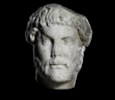Head of Hadrian
A Roman marble bust of the Emperor Hadrian (76-138). Although the head has been weathered with age, it is still clearly identifiable as Hadrian. It features his thick curls, combed forward towards the forehead, his closely cropped beard and thick moustache, as well as the distinctive fold across his ear lobes. The eyes sit under a strong brow and above the remains of the straight nose.
Hadrian reigned as emperor of Rome between 117 and 138 A.D.. He took over after the failure of Trajan’s final Parthian campaign and had to renounce many recently acquired territories in order to solidify the Empire’s borders. Because of this, he travelled almost constantly throughout the empire, and initiated an unparalleled building program across its width. As well as Hadrian’s Wall, marking the northern limit of Britannia, he rebuilt the Pantheon in Rome and constructed the Temple of Venus and Roma. He may have been responsible for the reconstruction of the Serapeum of Alexandria in Egypt. Hadrian held a strong admiration for Greece: he created a Panhellenic League of cities, and constructed the Temple of Zeus and the Arch of Hadrian in Athens in order to secure the loyalty of the Greek aristocracy.
A large number of portraits of Hadrian survive today, due to the length of his reign as well as his enduring popularity throughout the Roman Empire. As he came to power at the age of forty-one, Hadrian is depicted as a middle-aged man. He was the first emperor to wear a beard, starting a trend that would continue for several centuries. Some theorise that his beard served as a demonstration of his connection to the Roman legions, as young men on campaign in this period frequently wore beards. Most portraits of Hadrian fall into seven clearly recognised types, as outlined by Max Wegner. This example falls into either the second or third of Wegner’s types, which have several overlapping characteristics, dating it to the early Hadrianic period.
Previously in the Private Collection of Lucius Crowell, Jr. (1911-1988), Philadelphia, USA, brought back with him from Europe in the 1930s, prior to the outbreak of WWII. The head was kept on a pedestal by one of the entrances to his home in the 1950s, and Crowell painted a still life featuring the head in the 1970s, before moving it to the side of the house in a circular planter with some ivy. Accompanied by a photograph taken in June 1966.
Thence by descent to his son, Nicholas Crowell, Philadelphia, USA, and kept in the same house.
ALR: S00238969, with IADAA Certificate, this item has been checked against the Interpol database.
Lucius Crowell, Jr. (1911-1998) was born in Chicago, Illinois in 1911, to a prominent family. He graduated the Lawrenceville School in New Jersey, and then attended Williams College, before studying at the Pennsylvania Academy of the Fine Arts. Crowell continued his studies independently, with the American painters Franklin C. Watkins and Arthur B. Carles. He also studied at the Barnes Foundation in Philadelphia, and the Academie Scandinave and the Academie de la Grande Chaumiere in Paris. He painted in a realist style, depicting the everyday world with a touch of romanticism. Crowell was known for his seemingly unstylised execution, and was praised for his ability to paint in the traditional style of the Dutch masters as well as more modern styles, akin to Corot.
Crowell travelled extensively throughout Europe, painting Morocco, Greece, and particularly Italy. During his travels, he collected and brought back antique Venetian furniture, fine art, and architectural elements.
Crowell later returned to America to study ceramics at the Philadelphia College of Art and the Tyler School of Art at Temple University. In later years, he taught art at the Kent School in Connecticut, the Chester County Art Association, the Birchrunville Art Center, and in Wilmington, Delaware. His works were featured in exhibitions at the Philadelphia Museum of Art, the Whitney Museum, the National Academy of Art in Washington, the Art Institute of Chicago, the Philadelphia Art Alliance, and a one-man show at the Pennsylvania Academy of the Fine Arts in 1954. He was a member of the Philadelphia Art Alliance, Artists Equity, the Peale Club, and the Williams Club of New York. He died at his home in Charlestown Township, near Pheonixville, PA, in 1988.
Today, Crowell’s work can be found in the permanent collections of the Pennsylvania Academy of the Fine Arts, Philadelphia Museum of Art, Boston Museum of Fine Art, Lambert College, the Medical College of Pennsylvania, Temple University, University of Delaware, Columbus Gallery of Fine Art, and the Northfield Museum.










 Enquire
Enquire




